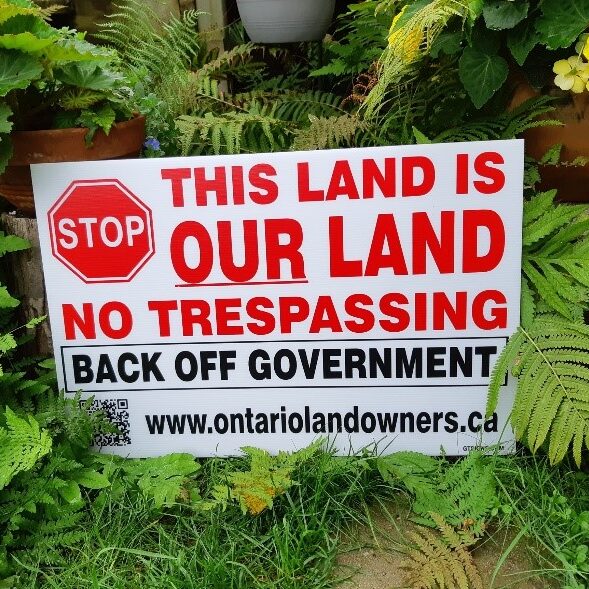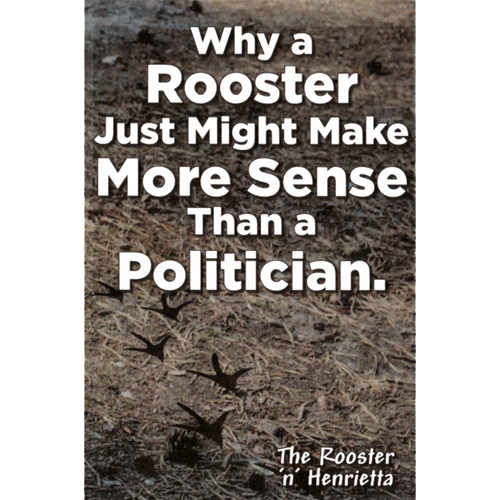Official Plans. A Blueprint to Shut Down Rural Ontario by Donna Burns
- 2016-09-01
- By admin
- Posted in Latest News
The FINAL public meeting on the Renfrew County Official Plan Amendment 25 (OPA 25) was held on Tuesday, Aug. 23rd in Renfrew at the Horton Twp. Community Centre. The last of seven such meetings…. this was the LAST CHANCE to learn about the County Official Plan and the impact it would have on private properties as a result of “land designations” being applied to determine what type of regulations will be enforced on our land-use conditions. See video from the last meeting at https://youtu.be/SRZpzJA0sso.
Many people have no idea what an Official Plan is. An Official Plan is mandated by the Province (Planning Act of Ontario) for municipalities to basically improve their infrastructure and issues policies on how land in their community should be used. This “land”, however, is land that belongs to the municipality or has control of….examples are parks and recreation, libraries, arenas, schools, churches, etc. (public services). It DOES NOT include private property unless there has been consent by the property owner to use his land for the purpose in providing a public service.
IF that is the case, obviously it is with the knowledge of the property owner. He’s been compensated for it and the consent should be recorded in the Land Registry Act. What the County was attempting to do was hold public meetings during the month of August when farmers are at their busiest, seasonal construction work is at its peak, and people are vacationing. The three big factors of concern were that (1) very few people understand what an Official Plan is; (2) the notice of these public meetings were only advertised in a few newspapers (not everyone gets a newspaper); and (3) the timing they chose to schedule these “public meetings” …..all with the appearance, this was intentionally planned with the hopes there were be little or no “objections” brought forward to their County Official Plan. In addition to that, there were also “rules” that unless you attended the meetings, you would never be aware that (1) they had a deadline of Sept. 30th to put in written submissions objecting to the Plan; (2) that you only had 20 days after the Plan was adopted to put in a second written submission this time to the Province (MMAH); and (3) you could only appeal the decision of the Official Plan to the Ontario Municipal Board IF you had previously put in a written submission. All these conditions based solely on your attendance at the public meetings.
Each member of the County Council as well as the Planners was provided with two reports for their consideration before they adopt this County Official Plan. The first report was Planning in Ontario, a report fully researched by the Ontario Landowners Association with footnotes included within it as reference for confirming the information provided within it. The second report was a Report prepared in 2003 during the reign of Dalton McGuinty (Small, Rural and Remote Communities: The Anatomy of Risk) which appears to be a blueprint of the government’s plan to shut down Small Communities, Rural, and Remote Communities in Ontario. Quotes under “Settlement Strategies” in this report spoke of: “Part of this settlement strategy will have to be devising innovative methods of planning for downsizing, or as defined above, planning for decline among existing communities”; and “convincing communities that their future is smaller”; and “working with those communities to achieve that shrinkage”; “Government services – especially education and healthcare – should be enhanced and strengthened in larger, better connected communities…”
This Report is 13 years old and we are now living and experiencing some of their planned strategies. We have the highest hydro rates in North America by a single utility that ONLY services rural Ontario. Our railway lines have been shut down, bus travel to the larger cities reduced, closing of rural postal offices – hours reduced in others, closing of some of our schools, the expansion of Hwy 17 closed for now; Canada Revenue threatening the closure of private camp grounds, in addition to losing services such as libraries, recreational programs, and so on and so forth. Now we are looking at enforced restrictions regulated on both waterfront properties and rural properties implemented through the provincial policy statement. These “regulations” under the umbrella of Environmental Protection & Endangered Species are designed to deny us the right to enjoy the use of our land, thereby making the land useless, decreasing its’ property value and forcing property owners to lose thousands of dollars on their investment….ultimately forcing the property owner to relocate elsewhere …”declining the population” and eventually “shutting down the community”. These strategies didn’t just happen overnight. It seems part of these “innovative methods in the planning for downsizing” were the creation of new legislation — The Endangered Species Act 2007, Provincial Policy Statements 2005 and 2014 … legislation that clearly allows the approval for some to be exempt from and private property owners to be charged with (e.g., developers in bed with municipalities draining swamps for more development in the cities, or municipalities allowing the dumping of raw sewage into the river). One would think this McGuinty Report was created from Hitler’s quote: The best way to take control over a people and control them utterly is to take a little of their freedom at a time, to erode rights by a thousand tiny and almost imperceptible reductions…”
After attending all the public meetings, the County Planner and Staff along with any public officials who attended some of the public meetings were informed of some of the items below:
- As mentioned in both the Planning & Municipal Acts, the municipality must acquire the land with the consent of the property owner before they can do anything on it.
- Any change where another entity shall govern the use of the private property must be in agreement with the property owner and registered on Title at the Land Registry Office; this is similar to an easement between Bell Canada and a property owner where Bell has been granted approval in the form of an agreement allowing them the use of a portion of that private property.
- It is written in the Constitution that the government cannot interfere with any “trusts” or interests that do not belong to the province (letters patent) unless otherwise “reserved”, (e.g., MNR for wetlands) …meaning they (the province) cannot interfere with private property
- It states in the Municipal Act, any member of council, employee, or agent may be at risk of civil litigation brought against them for not acting in good faith.
o holding public meetings without informing those members of the public, whom council considers may have an interest in the Official Plan, is “acting in bad faith”
o using the absence of attendance at the public meetings as “implied consent” to give the green light as approval of the Official Plan is not acting in good faith.. - Using absence of attendance by the public who had no knowledge of the meetings or what an official plan is, to be considered as “implied consent” granting approval to proceed with the Official Plan, thereby bringing in regulated enforcement in controlling the land use conditions without the written consent of the property owner is illegal and unacceptable and definitely…..not acting in good faith as per section 448.2 of the Municipal Act.
- This attempt of taking control of private land is expropriation without compensation – a major violation of the Expropriations Act.
- There is a study by world economists like Hernando De Soto from Peru who did a world-wide study that proved Protection of Property Rights is the key element to Economic Development, ultimately bringing Prosperity to its country. This study compared and showed that those countries that do not have protection of Property Rights live in poverty. Why is Renfrew County taking the path to poverty by attempting to remove our property rights?
Through word of mouth and other means of communication, the final public meeting had standing room only. The County witnessed firsthand, from the attendance alone, that the “public” is not happy with the County Official Plan and does not support it.
Search:
Categories
Archives
- April 2024
- January 2024
- December 2023
- November 2023
- August 2023
- July 2023
- June 2023
- May 2023
- April 2023
- March 2023
- February 2023
- January 2023
- December 2022
- November 2022
- October 2022
- September 2022
- August 2022
- July 2022
- June 2022
- May 2022
- April 2022
- March 2022
- February 2022
- January 2022
- December 2021
- November 2021
- October 2021
- September 2021
- August 2021
- July 2021
- June 2021
- May 2021
- April 2021
- March 2021
- February 2021
- January 2021
- December 2020
- November 2020
- October 2020
- September 2020
- August 2020
- July 2020
- June 2020
- May 2020
- April 2020
- March 2020
- February 2020
- January 2020
- December 2019
- November 2019
- October 2019
- September 2019
- August 2019
- July 2019
- June 2019
- May 2019
- April 2019
- March 2019
- February 2019
- January 2019
- December 2018
- November 2018
- October 2018
- September 2018
- August 2018
- July 2018
- June 2018
- May 2018
- April 2018
- March 2018
- February 2018
- January 2018
- December 2017
- November 2017
- October 2017
- September 2017
- August 2017
- July 2017
- June 2017
- May 2017
- April 2017
- March 2017
- February 2017
- January 2017
- December 2016
- November 2016
- October 2016
- September 2016
- August 2016
- July 2016
- June 2016
- May 2016
- April 2016
- March 2016
- February 2016
- January 2016
- December 2015
- November 2015
- October 2015
- September 2015
- August 2015
- July 2015
- June 2015
- May 2015
- April 2015
- March 2015
- February 2015
- January 2015
- December 2014
- November 2014
- October 2014
- September 2014
- August 2014
- July 2014
- June 2014
- May 2014
- April 2014
- March 2014
- February 2014
- January 2014
- December 2013
- November 2013
- October 2013
- September 2013
- August 2013
- June 2013
- April 2013
- October 2012
- May 2012
- September 2011



